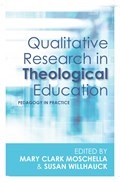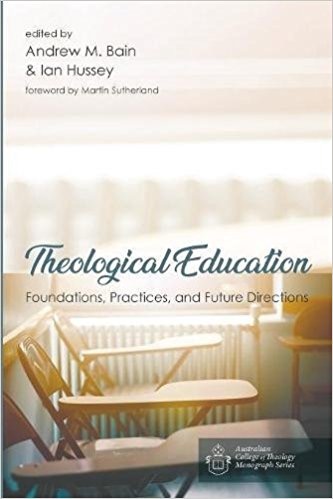theological education
Select an item by clicking its checkbox

Qualitative Research in Theological Education: Pedagogy in Practice
Date Reviewed: April 16, 2019
If you are looking for a current collection of essays about the state of qualitative research in theological education, then this volume edited by Moschella and Willhauck will be extraordinarily useful. The contributors offer a broad-based, international approach to their topic, complete with case studies and a select bibliography. Together, they argue that qualitative research is essential to the formation of ministers and theological scholars.
Moschella’s introduction provides a concise overview of how this collaborative project began, key themes in the field of ethnographic studies, and how each of the essays addresses these issues. There is real value here for the reader who is just plunging into the study of qualitative research and needs an overview of how the discipline is developing.
This is a handbook in four parts, with fifteen chapters. As such, it is designed for both reading and reference. In addition to the introduction, most readers will benefit from the first two entries that comprise
Part One, “Exemplary Research Essays.” Whitmore’s essay, “Theology as Playbook and Gamefilm: Explaining an Ethnographic Approach to Theology to a Sports-Centred Culture,” uses sports analogies to underscore the vital connection between theology and practice. This is one of several essays that emphasize the theological nature of ethnographic research. For theological educators, this is an important contention which broadens the discussion beyond contrasting qualitative versus quantitative methods and goals. Just how inclusive that discussion can become is indicated by Sorajjakool and Prachyapruit in “Qualitative Methodology and Pedagogy: A Study of the Lived Experiences of Thai Peasants within the Context of Western Development Ideology.”
Part Two, “Issues in Education and the Practice of Research,” includes ten chapters that emphasize the embodied and contextual nature of qualitative research. They are also a reminder that the interdisciplinary nature of this work is a necessary and fitting response to the complexity and messiness of real life. While there are several strong essays in this group, particular note should be taken of “Promoting the Good: Ethical and Methodological Considerations in Practical Theological Research” by Graham and Llewellyn, along with “Just Don’t Call It ‘Ethnography’: A Critical Ethnographic Pedagogy for Transformative Theological Education” by Wigg-Stevenson.
Part Three, “Integrating Qualitative Research into Theological Education”, includes Mellott’s “Qualitative Research in Theological Curricula” and Clarke’s “Wonder and the Diving Dance: The Lived Reality of Qualitative Research within a Master of Divinity Curriculum.” Both essays are valuable for theological educators and will repay rereading. The concluding section, Part Four, “Valediction,” is a single essay by Willhauck, “The Gift and Challenge of Qualitative Methods for Pastoral Formation.” Four major themes for teaching qualitative research are identified and briefly discussed including: contextualization, communication, reflection/reflexivity, and vocation (264). Willhauck’s elaboration on these themes makes a fitting conclusion to this extraordinarily rich and suggestive resource.
“Toto, we’re not in Kansas anymore.” So many of our students have a “Dorothy” experience when they enter theological and religious education. Our classrooms are not what they have had previous experience of. Our classrooms are not the local church, not Bible college, not the family reunion, not church ...
At the time of this conversation, Eric Barreto was on the faculty at Luther Seminary, but he has since joined the faculty at Princeton Theological Seminary. His teaching practice is informed by his bi-regional and multi-lingual backgrounds. The biblical text and the ancient world are sites for destabilizing contemporary notions about the stability of historical conceptions of the possibility/ies of living harmoniously within diverse communities.
The “I” That Teaches - A new video project that invites senior scholars to talk about their teaching lives. These scholar-teachers candidly discuss how religious, educational, and family backgrounds inform their vocational commitments and, also, characterize their teaching persona. From the vantage point of a practiced teaching philosophy we get an intimate account of the value and art of teaching well.
Click here to watch all episodes of "The "I" That Teaches" on YouTube
See Also:

Theological Education: Foundations, Practices, and Future Directions
Date Reviewed: October 1, 2018
This edited volume of 21 articles explores the biblical and theological perspectives, historical foundations, current practices, and future directions of theological education in Australia and was published as part of the Australian College of Theology Monograph Series. The authors represent a wide array of theological disciplines including church history, Old Testament, New Testament, pastoral studies, Christian education, evangelism, spirituality, and theology. In addition to their academic disciplines, the authors come from a variety of backgrounds including adjunct faculty, faculty, administrators from academic intuitions and from the Australian and New Zealand Association of Theological Schools, as well as pastors mainly from evangelical perspectives.
Building upon the concept that the church follows where theological education leads, the editors of this volume, Bain and Hussey, argue in their introduction that “theological education is too important a task to be done without careful and ongoing thought. The imperative to be reflective about how we go about our task as theological educator is amplified dramatically by the changing world in which we live” (xix). This volume attempts to survey this current reflection on theological education in the Australian context.
The first section of this volume, Biblical and Theological Perspectives, offers three chapters that explore how the ontological view of the centers of theological education impact their praxis. These three chapters represent one of the most insightful parts of this book as the three authors all successfully explore how theological assumptions and perspectives shape how theological education has and is happening in Australia. Barker explains “I offer my reflections on how an evangelical understanding of what we are teaching should shape how we teach it” (4). Many of these same concepts emerge in Starling’s article, “The Scribe, the Steward, and the Inhabiting Word,” where Starling asks how these three metaphors “inform the way in which we seek to shape the curriculum for theological education in our own time and the institutions within which we teach it?” (25).
In the second section, Historical Perspectives, six articles explore the historical foundations of theological education in Australia. These chapters examine a variety of themes including theological education in early Christianity, models of western theological education, the impact of American theological education (especially the recently closed Andover Theological seminary), as well as Australian specific chapters with histories of the Australian College of Theology and Sydney Missionary and Bible College.
The third and largest section of this book, Current Practices, provides nine articles that examine a variety of current perspectives and groups within Australian theological education including: women, the Chinese immigrants, missional approaches, spiritual formation, attrition, cross-culture ministry, and an empirical exploration of who is currently engaged in theological education.
The final section, Future Directions, offers three articles that explore future directions of theological education in the Australian context. Although these three authors provide solid chapters on telecommuting staff and challenges for theological education, this is the weakest section of this volume. After providing a broad foundation with historical perspective and current practices, the future directions lack the visionary perspectives of the rest of the book. It would have been wonderful if this section could have been expanded to examine many of the challenges identified in the Current Practices section.
This title provides a valuable piece to the puzzle of theological education around the globe. Theological education is a complex endeavor and through the contextualization of various methods and historical models to it, the challenge of theological education can be addressed with wit and wisdom. This is an important volume and should be added to the collection of major theological libraries and institutions that explore the history of religion and/or approaches to theological education.

Teaching for a Multifaith World
Date Reviewed: December 12, 2017
The public arena of the 21st century has become one in which religious intolerance and inflammatory and questionable assertions about religions and specific groups of people are not only acceptable to many persons but are frequently invited and modeled by community leaders at many levels of mainstream American culture. Religious leaders who might model critical public engagement and expose ignorant and dangerous misrepresentations of whole faith communities are rarely represented in media. Meanwhile, current data suggests that more than 25 percent of married couples in America are interfaith. How do seminaries prepare students to minister in a global society where fear, lies, and misunderstandings are rampant and where interreligious understanding and cooperation are so essential to human survival and community?
Most seminaries have already recognized one basic assertion of this book -- that seminary teaching is not about pouring stable and unchanging religious content into our students. Healthy seminaries of the 21st century are called instead to help students grow deep and secure roots in their faith tradition such that fear of the Other will be replaced by curiosity and engagement while appreciating, practicing, and honoring their own faith identity. Such secure attachment to their faith identities will help students minister in the multifaith contexts they are likely to encounter while offering pastoral care in any community they serve. Fernandez and his colleagues offer thought-provoking, creative chapters on spiritual formation, curriculum development, multifaith pastoral care, and public ministry in the age of terrorism and over-the-top propaganda, lies, and misunderstandings that have created the fear and isolation of American religious and secular culture.
Teaching in a Multifaith World includes chapters that address seminary education from the perspective of theoretical lectures and models to practical guidelines and principles. For example, in chapter 3, Mary Hess asserts that current students benefit from the almost universal experience of video gaming and are more open to collaborative learning, recognition of human fallibility, and acceptance of change than faculty may believe. Today’s students, she believes, are used to learning from experience, reflection, retrying, and developing skills at noticing differences and similarities that provide clues to choices they need to make. Hess advises faculty to build on these skills by exploring in vivo experiences of relationship with those of other faiths. Multifaith learning need not relativize beliefs as having equal truth but should ground students in humility that enables engagement with other faiths while deepening one’s own religious roots and identity. Helping students explore rather than debate the verity of other faiths decreases the fear that comes from ignorance and diminishes the power of fear-based claims and labels propounded in the public sphere.
Kujawa-Holbrook’s chapter is the capstone of the volume and begins by asserting that “Interreligious learning emanates from the collective belief that we are all, despite our religious differences, part of one human community” (199). She offers aspirational characteristics of healthy religious communities that can be generalized to most congregations. Communities of faith must first be able to sustain relationships of mutual care and respect that embody belief in the dignity of every human being within their own community. Healthy relationships within one’s home community become indicators of healthy relationship potential with those outside one’s own community. Hospitality is not just a welcome sign on the door, but includes an awareness of food choices, timing of Sabbath, and an open-hearted welcome of strangers. The proliferation of multifaith families presents congregations with opportunities for interreligious understanding (as opposed to conversion possibilities) as the presence of such families unearths hitherto unknown varieties of holiday celebrations, birthing and funeral traditions, premarital counseling needs, and a multitude of other learnings.
While many experienced faculty were trained to offer the stable and enduring truths of a given faith perspective, post-modern and post-colonial studies have created recognition of the need for fluency in the changing nature of knowledge and the importance of self-awareness of one’s perspective and experiences such that knowing, honoring, and speaking from one’s specific religious identity involves openness to engagement with others in a spirit of curiosity and respect. Seminaries and their graduates have a role to play in helping to create bridges between different communities (religious and other) rather than walls. Those seminaries moving toward building bridges would do well to assign Teaching in a Multifaith World as required faculty reading.
